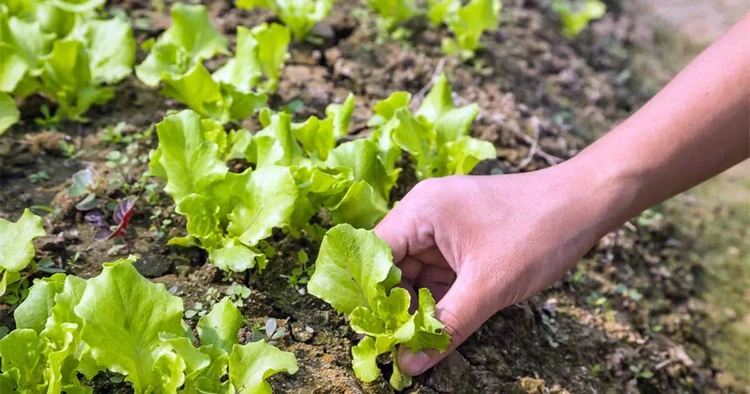Do you like to eat fresh green salad? Are you ready to learn how to plant lettuce? This popular leafy vegetable is one of the easiest crops to grow in flower beds and containers, and it’s ideal for spring harvesting. In addition, young shoots are ready to be picked about a month after planting lettuces and whole heads can be harvested in about two months. Growing your own crops is an easy way to save on grocery bills and enjoy months of organic home production.
Everything You Need to Know About Planting Lettuces
Lettuce is a cool weather crop and is best grown in the spring. Seeds germinate at temperatures as low as 4°C/39F but the ideal temperature for germination and growth is between 16-18°C/60 – 64F. If you plant lettuce in batches, 10 or 14 days apart, you will get a longer harvest period. To avoid summer wilt, stop planting a month before the onset of hot summer temperatures. Growing lettuce from seedlings for transplanting in early spring is a good way to plan an early growing season.
Also read: What Vegetables for Winter to Plant in the Summer? Follow This Guide to Get Fresh Veggies!
How to Grow Different Types of Lettuce?
The great news is that lettuce grows pretty quickly. Of course, it depends on the variety, but the general rule of thumb is that they can be harvested after 30 days. Some types need 6 to 8 weeks to grow before harvesting.
Green and red leaf lettuce varieties are the easiest to grow. You can plant them in rows or in a container. If you want to have 2 or 3 harvest of green and red leaf lettuce, trim the leaves a few inches above the soil.
Romaine Lettuce needs 60 to 80 days from planting to harvest. This type of lettuce does not bolt in the warm summer temperatures which makes it ideal if you are looking for a long harvest period.
Where to Plant Lettuce?
To grow great lettuce, find a location that provides at least six to eight hours of direct sunlight. It is possible to grow the plants in partial shade (three to four hours of sun), but in low light it is advisable to plant loose leaf varieties which grow faster than spike varieties. Once you’ve chosen your location, prepare the bed for planting by adding an inch or two of compost or aged manure. If you wish, you can also add a slow-release organic fertilizer. Lettuce is sensitive to low pH, it needs a soil with pH of 6.5 to 6.8.
Lettuce is also a fantastic outdoor container plant as it has a shallow root system. It can be grown in a pocket herb garden, window boxes, fabric planters, baskets or any other container at least 10-15cm/4-5 inches deep and with drainage holes.
To start harvesting lettuces, cover your early spring beds with fabric or plastic mini-tunnels. They capture solar energy and protect against cool temperatures and frost.
How to Plant Lettuce Seeds?
The first spring lettuces can be planted from the month of January, under cover. It doesn’t take much work to grow these vegetables from seed. Lettuce seeds are often quite small and only require a planting depth of 0.6 to 1.2 cm/0,2 to 0,5 inches. Planting lettuce in rows will give your garden a traditional look. You can alternate rows of green and red lettuce for a whimsical touch.
The distance at which to plant the seeds depends on the chosen variety. If you are sowing spring lettuces directly into the ground, you should space your rows 30 to 45 cm/11-15 inches apart. The ideal distance between leaf lettuce seedlings is 10 cm/4 inches; for romaine lettuce and head lettuce it should be 15 to 20 cm/6-8 inches. Head lettuce is usually grown from seed started indoors for a spring garden. Transplant this variety in rows 25-30cm/10-12 inches apart, with 30-45cm/11-15 inches between each plant.
Transplanting Lettuce
When transplanting lettuce into garden beds or containers, plant in a grid pattern, spacing each plant about 15cm/6 inches apart. This is where you can have a little fun if you are growing multicolored varieties. You can arrange the colors to create a checkerboard pattern.
If transplanting in rows, space the seedlings 25-30cm/10-12 inches apart and the rows 30-45cm/11-15 inches apart, depending on the mature size of the variety. Check your seed packet label for specific spacing instructions.
Planting Lettuce Seeds in Succession
Wondering how to plant lettuce to have a really long harvest season? The secret is succession planting! This means to sow seeds at different times.
Successive crops come from extra lettuce seeds that you can sow every two or three weeks from early January until early summer. Finally, by sowing throughout the spring or fall, you will get an plentiful harvest of high quality greens.
How to Protect Lettuce form Disease and Pests
Aphids, snails, slugs and caterpillars love lettuce and can destroy your corps. You should pick the snails and caterpillars by hand or use organic solutions. As for aphids, it is best to use horticultural soap or neem oil in order to get rid of them.







